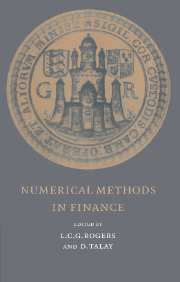Book contents
- Frontmatter
- Contents
- Contributors
- Introduction
- Convergence of Numerical Schemes for Degenerate Parabolic Equations Arising in Finance Theory
- Continuous-Time Monte Carlo Methods and Variance Reduction
- Recent Advances in Numerical Methods for Pricing Derivative Securities
- American Options: A Comparison of Numerical Methods
- Fast, Accurate and Inelegant Valuation of American Options
- Valuation of American Option in a Jump-diffusion Models
- Some Nonlinear Methods for Studying Far-from-the-money Contingent Claims
- Monte Carlo Methods for Stochastic Volatility Models
- Dynamic Optimization for a Mixed Portfolio with Transaction Costs
- Imperfect Markets and Backward Stochastic Differential Equations
- Reflected Backward SDEs and American Options
- Numerical Methods for Backward Stochastic Differential Equations
- Viscosity Solutions and Numerical Schemes for Investment/Consumption Models with Transaction Costs
- Does Volatility Jump or Just Diffuse? A Statistical Approach
- Martingale-Based Hedge Error Control
- The Use of Second-Order Stochastic Dominance To Bound European Call Prices: Theory and Results
Viscosity Solutions and Numerical Schemes for Investment/Consumption Models with Transaction Costs
Published online by Cambridge University Press: 05 June 2012
- Frontmatter
- Contents
- Contributors
- Introduction
- Convergence of Numerical Schemes for Degenerate Parabolic Equations Arising in Finance Theory
- Continuous-Time Monte Carlo Methods and Variance Reduction
- Recent Advances in Numerical Methods for Pricing Derivative Securities
- American Options: A Comparison of Numerical Methods
- Fast, Accurate and Inelegant Valuation of American Options
- Valuation of American Option in a Jump-diffusion Models
- Some Nonlinear Methods for Studying Far-from-the-money Contingent Claims
- Monte Carlo Methods for Stochastic Volatility Models
- Dynamic Optimization for a Mixed Portfolio with Transaction Costs
- Imperfect Markets and Backward Stochastic Differential Equations
- Reflected Backward SDEs and American Options
- Numerical Methods for Backward Stochastic Differential Equations
- Viscosity Solutions and Numerical Schemes for Investment/Consumption Models with Transaction Costs
- Does Volatility Jump or Just Diffuse? A Statistical Approach
- Martingale-Based Hedge Error Control
- The Use of Second-Order Stochastic Dominance To Bound European Call Prices: Theory and Results
Summary
Introduction
In this article we examine a general investment and consumption decision problem for a single agent. The investor consumes at a nonnegative rate and he distributes his current wealth between two assets. One asset is a bond, i.e. a riskless security with instantaneous rate of return r. The other asset is a stock, whose price is driven by a Wiener process.
When the investor makes a transaction, he pays transaction fees which are assumed to be proportional to the amount transacted. More specifically, let xt and yt be the investor's holdings in the riskless and the risky security prior to a transaction at time t. If the investor increases (or decreases) the amount invested in the risky asset to yt + ht (or yt - ht), the holding of the riskless asset decreases (increases) to xt - ht - λht (or yt + ht - µht). The numbers λ and µ are assumed to be nonnegative and one of them must always be positive. The control objective is to maximize, in an infinite horizon, the expected discounted utility which comes only from consumption. Due to the presence of the transaction fees, this is a singular control problem.
Our goals are to derive the Hamilton–Jacobi–Bellman (HJB) equation that the value function solves and to characterize the latter as its unique weak solution, to come up with numerical schemes which converge to the value function as well as the optimal investment and consumption rules and to perform actual numerical computations and compare the results to the ones obtained in closed form by Davis & Norman.
- Type
- Chapter
- Information
- Numerical Methods in Finance , pp. 245 - 269Publisher: Cambridge University PressPrint publication year: 1997
- 7
- Cited by



